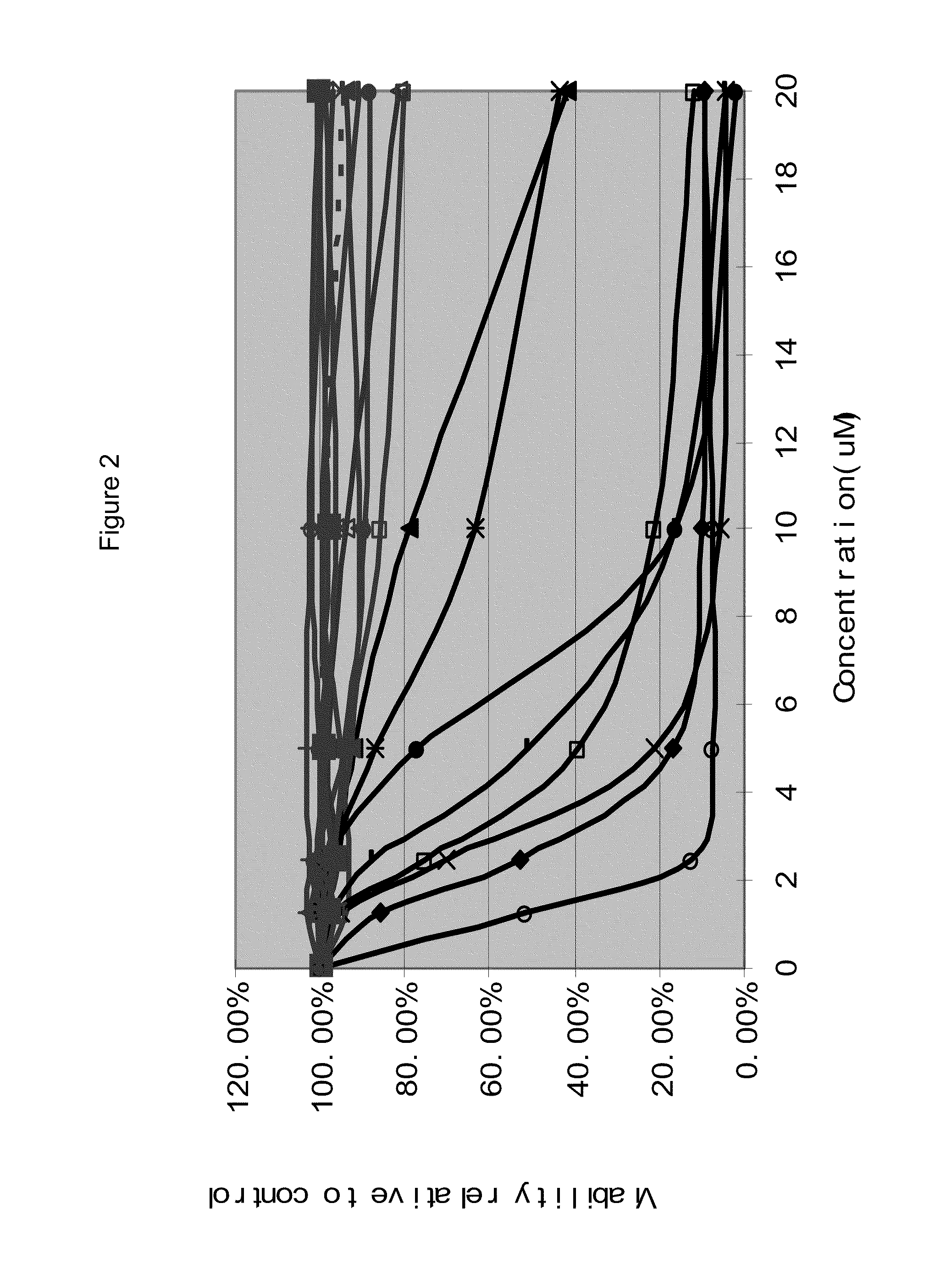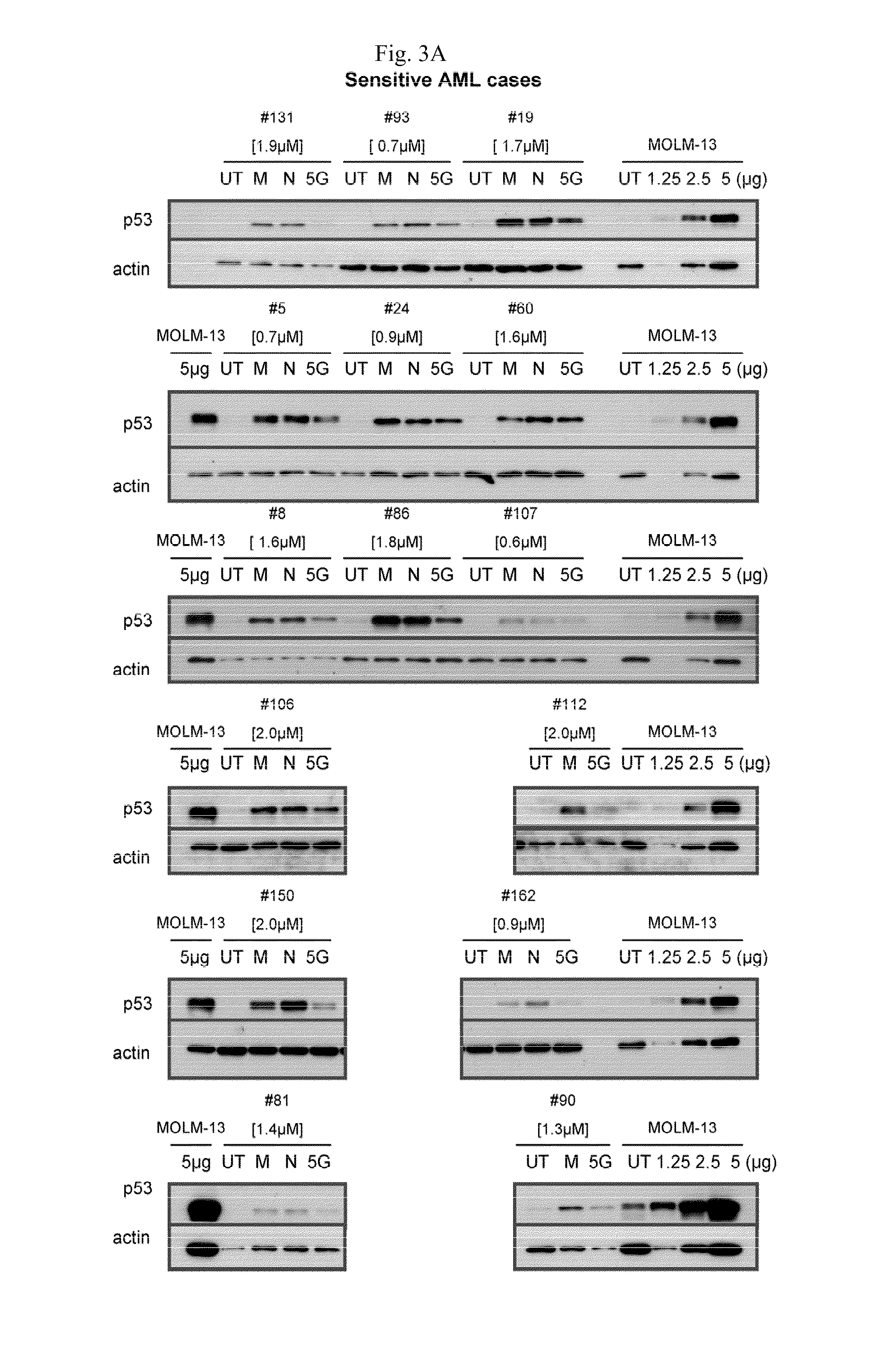Biomarkers for mdm2 inhibitors for use in treating disease
- Summary
- Abstract
- Description
- Claims
- Application Information
AI Technical Summary
Benefits of technology
Problems solved by technology
Method used
Image
Examples
example 1
Methods
Patients
[0332]The 109 AML cases analyzed in this study were enrolled at the University of Michigan Comprehensive Cancer Center between March 2005 and October 2009. The study was approved by the University of Michigan Institutional Review Board (IRBMED #2004-1022), and written informed consent was obtained from all patients prior to enrollment.
Cell Purification
[0333]Peripheral blood mononuclear cells from AML patients were isolated by Ficoll gradient centrifugation (GE Healthcare), aliquoted into FCS with 10% DMSO, and cryopreserved in liquid nitrogen. For purification of AML blasts using negative selection, cryopreserved PBMCs derived from AML patients were washed and recovered by centrifugation and then treated with anti-human CD3 (Miltenyi Biotec #130-050-101), anti-human CD14 microbeads (if blasts were negative for CD14 expression; Miltenyi Biotec #130-050-201), anti-human CD19 (if blasts were negative for CD19 expression; Miltenyi Biotec #130-050-301) and anti-human CD235...
example 2
[0344]Characteristics of the 109 AML patients analyzed in this study are summarized in Table 1. Of the 109 AML cases analyzed, 90 (83%) were previously untreated and 19 (17%) were previously treated (relapsed) at study enrollment. Seventy percent, 14%, and 16% were either primary, secondary or treatment related AML (tAML), and 12 cases had p.53 exon 5-9 mutations.
TABLE 1Baseline characteristics of patientsTreatment-naïve atPreviously treated atCharacteristicenrollment, no. (%)enrollment, no. (%)Sample Size (N = 109)90 (83)19 (17)Age, yMedian6260Range20-8524-79SexMale53 (59)11 (58)Female37 (41) 8 (42)PathogenesisDe novo61 (68)15 (80)Prior myelodysplasis13 (14) 2 (10)Treatment-related16 (18) 2 (10)FAB classification*M011 (12) 0 (0)M113 (14) 4 (21)M214 (16) 2 (11)M3 0 (0) 0 (0)M433 (37) 6 (32)M5 6 (7) 3 (16)M6 0 (0) 0 (0)M7 0 (0) 0 (0)Cytogenetic class**Favorable 6 (7) 0 (0)Intermediate48 (53)17 (90)Unfavorable36 (40) 2 (10)No. of karyotypicabnormalitiesThree or ...
example 3
Primary Resistance to MDM2 Inhibitor Treatment is Common in Adult AML
[0345]To evaluate the efficacy of MDM2 inhibitor-mediated apoptotic cell kill in AML blasts ex vivo, blasts from 109 AML specimens (97 with wild type p53 and 12 with mutant p53 by exon 5-9 exon sequence analysis) were purified to >90% purity and cell aliquots were incubated for 40 hours with escalating concentrations of the MDM2 inhibitors MI-219 (N=109) and MI-63 (N=60). The apoptotic cell fraction in treated samples was subsequently quantitated through annexin V-PI-based FACS analysis and normalized to measurements in paired untreated cells. As can be seen in FIGS. 1A and 1B, all AML cases with mutant p.53 exon 5-9 (red) or absent p53 mRNA expression (green) displayed resistance to MDM2-inhibitor treatment, consistent with previous findings (Kojima, K. et al, Blood 106: 3150-3159 (2005); Saddler, C. et al., Blood 111: 1584-1593 (2008).
[0346]While many AML cases with wild type p53 exon 5-9 (black) were very sensit...
PUM
| Property | Measurement | Unit |
|---|---|---|
| Volume | aaaaa | aaaaa |
| Molar density | aaaaa | aaaaa |
| Molar density | aaaaa | aaaaa |
Abstract
Description
Claims
Application Information
 Login to View More
Login to View More - R&D
- Intellectual Property
- Life Sciences
- Materials
- Tech Scout
- Unparalleled Data Quality
- Higher Quality Content
- 60% Fewer Hallucinations
Browse by: Latest US Patents, China's latest patents, Technical Efficacy Thesaurus, Application Domain, Technology Topic, Popular Technical Reports.
© 2025 PatSnap. All rights reserved.Legal|Privacy policy|Modern Slavery Act Transparency Statement|Sitemap|About US| Contact US: help@patsnap.com



